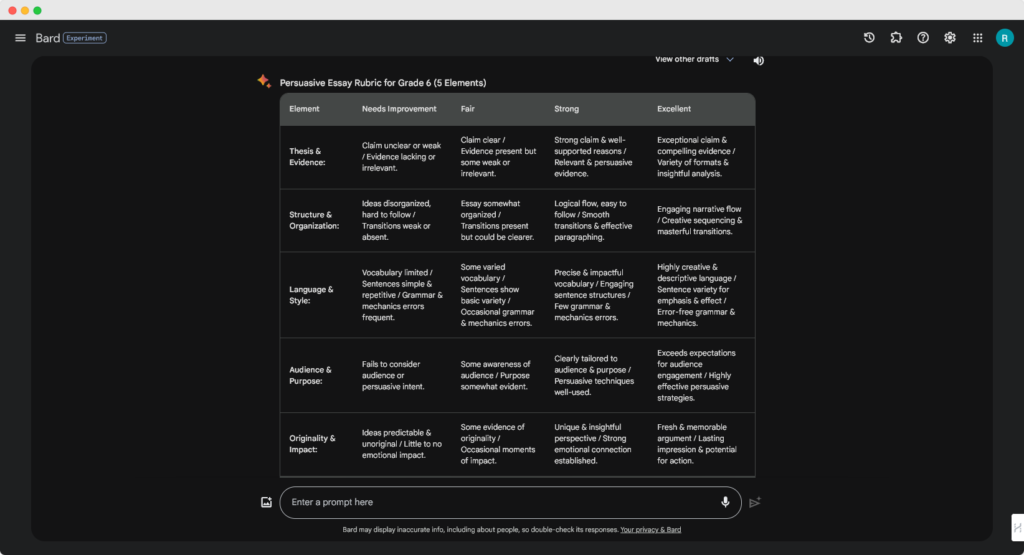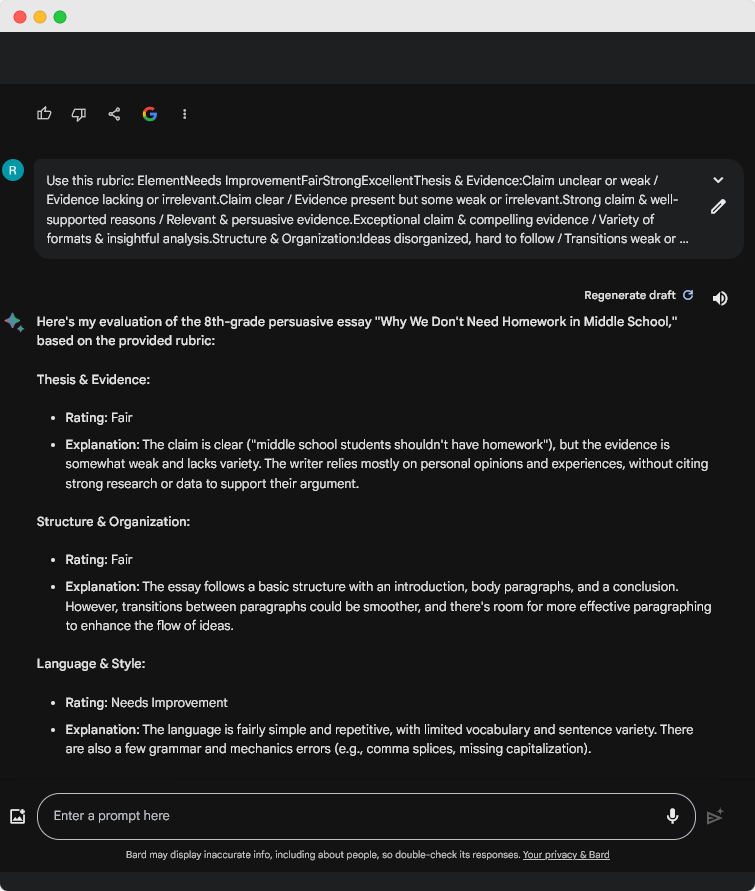Introduction
Imagine a world where grading essays doesn’t have to be the daunting, time-consuming task that keeps you up at night. While a smart AI assistant grades essays, you relax with your favorite coffee.

Welcome to the future of education with Google Bard! This isn’t just a daydream; it’s the new reality for educators around the globe. Google Bard, an AI marvel, is changing the game in educational settings, offering a helping hand in grading student essays.
But how exactly does this work? In this post, we’re unpacking the magic behind using Google Bard for essay grading. We’ll help you set up Bard, create a custom rubric, and watch student essays integrate with Google Docs.
Say goodbye to the overwhelming piles of papers and hello to a streamlined, efficient grading process. Please join me in this exciting journey to transform education with technology!
Understanding Google Bard
Welcome to the world of Google Bard, a cutting-edge AI tool that’s making waves in the educational landscape. But what exactly is Google Bard, and why is it becoming a go-to resource for educators?
In this section, we’ll explore Google Bard and show you what it can do and why it’s becoming more popular in schools and colleges.
A Quick Introduction to Google Bard
Google Bard is an advanced tool that is part of the AI revolution and is meant to help with many things, such as grading student essays.
It’s built on sophisticated algorithms that enable it to understand and process text in a way that mimics human understanding.

This AI doesn’t just look at words; it also understands tone, context, and subtleties. This makes it a very useful tool for education.
Teachers who know what Bard can do can use it to do more than just grade essays. They can also use it to give students helpful feedback.
Bard can handle tasks that would take humans hours or days to complete due to its fast and accurate text processing. This level of efficiency changes the way teachers grade.
The Relevance of Google Bard in Educational Settings
In an educational setting, Google Bard stands out for its ability to adapt to different grading criteria. Alter Bard for research, argument, and descriptive essays to meet grades. Its versatility extends to various educational levels, from high school to university courses.
Also, Google Bard makes grading more consistent. Human graders, no matter how experienced, can have variances in their grading due to factors like fatigue or subjective bias.
The same criteria are used for all essays at Bard, ensuring fairness and objectivity that’s hard to achieve manually.
Customizing Google Bard for Essay Grading
Grading essays can be a mountain of work, but with Google Bard, this mountain just turned into a molehill! Changing how Bard is set up to fit your specific grading needs is not only smart; it changes everything.
Let’s walk through how to tailor Bard to your classroom, ensuring it grades just the way you need it to.
Inputting Grading Criteria
Rubric Import
The first step in aligning Bard with your grading style is through rubric import. If you’ve got a rubric you’ve already been using, great! You can upload it straight into Bard.

If you’re looking to tweak your rubric, Bard can lend a hand. It can help refine your existing rubrics, ensuring they’re up to snuff. This means your grading standards are exactly what you want them to be: clear, concise, and fair.
Keyword and Criteria Definition
Next up, define key terms and criteria. This is like giving Bard a cheat sheet for what’s important in your essays.

By laying out the key terms and grading criteria, you’re guiding Bard on what to look out for. This ensures that the AI understands the heart of your grading process, from thesis statements to evidence use.
Feedback Templates
Feedback is where the learning happens. With Bard, you can craft custom feedback templates for different score ranges.

The templates can provide specific suggestions for improvement, so students don’t just get a grade but also advice on how to improve.
Fine-tuning the AI
Personalize Feedback
Your feedback style is unique, and Bard gets that. You can set the tone and level of detail for the AI-generated feedback.
Bard can match the tone you want for feedback, whether it’s positive or negative, so it feels personal and useful.
Calibration with Sample Essays
Calibration is key. By providing sample essays and your grades for them, Bard starts to understand what you look for in student work.

This is a very important step because it makes sure that Bard’s grading standards are in line with yours. This will ensure that grades are consistent and correct.
Continuous Learning
Bard isn’t just a set-it-and-forget-it tool. It learns and evolves.
By continuously feeding it graded essays and your feedback, you’re refining its accuracy. Over time, Bard becomes more aligned with your grading style, making it a more effective grading partner.
Testing and Adjusting Bard
Pilot Run
Before going full swing, a pilot run is a smart move. Grade a small batch of essays with Bard and compare their results with your own.

This is like a test drive, giving you a clear picture of where Bard shines and where it needs tweaking.

Refine Settings Based on the Pilot Run
Based on your pilot run, you might need to adjust the criteria, prompts, or feedback templates.
This step is about fine-tuning Bard to ensure it grades just as accurately as you would.
Embrace Iteration
Remember, perfection comes with practice. Optimizing Bard is an ongoing journey.
Continuously test, adjust, and learn. This way, Bard becomes more than just a tool; it becomes your AI grading partner, evolving to meet your needs.
Conclusion on Customizing Bard
You’re now equipped to turn Bard into your AI assistant, tailored to your unique grading style.
By harnessing the power of AI, you’re not just making your life easier; you’re enhancing the learning experience for your students. Welcome to the future of essay grading—efficient, personalized, and insightful.
Limitations of Google Bard
In the journey of integrating Google Bard into our grading system, it’s crucial to be aware of its limitations. Teachers can plan better how to use Bard to supplement traditional ways of grading if they know where it might fall short.
Inability to Capture Nuances
One major problem with Bard is that it might not be able to pick up on the subtleties of student writing. It works well with structured essays, but it might not fully understand context, creativity, or originality.
With tasks that require students to express themselves and think creatively, a supervisor is essential. Educators are essential in recognizing and valuing these aspects that AI might overlook.
Bias and Fairness
Another concern is the possibility of AI absorbing biases from its training data. This can lead to unfair grading outcomes, especially for certain groups of students.

To combat this, it’s vital to ensure the fairness of Bard’s training data and remain vigilant about potential biases in its grading. Regular reviews and updates can help maintain an equitable grading system.
Inability to Understand Content
Bard may not always fully understand the content of an essay. Bard may be misled by essays that use fancy words but don’t have much to say, which could lead to wrong grades.
This problem shows how important it is to combine Bard’s technical skills with the teacher’s subject knowledge. It’s about finding the right balance between AI efficiency and human understanding.
Lack of Human Communication
AI, including Bard, lacks the ability to read, think, or feel like humans. This inherent limitation restricts its capacity to comprehend and evaluate writing in the deeply nuanced way a human can.
Bard can’t think or talk like humans do, so it needs teachers to help it understand, interpret, and make subjective judgments about things.
Ethical and Moral Implications
The use of AI in grading also raises ethical and moral questions. If we use AI to grade schoolwork, we need to carefully think about what that means.

Teachers should learn how to use Bard, know what its limits are, and teach their students about its purpose and limits. This awareness is key to the ethical and responsible use of AI in education.
Conclusion on Bard’s Limitations
Recognizing these flaws doesn’t make Bard less useful; instead, it helps us use it better. Bard’s strengths should be used, and our human insight and expertise should be used to make up for its weaknesses.
Our reliance on technology should improve, not hurt, the learning experience. This balanced approach makes sure of that.
Conclusion: Embracing the Future of Grading with Google Bard
As we wrap up our deep dive into Google Bard and its use in essay grading, let’s reflect on the journey we’ve taken. We’ve explored how to set up Bard, customize it to our grading style, and integrate it with tools like Google Docs and Sheets.
We also talked about the important things like knowing its limits and the moral issues that come up with using AI in schools.
Embracing AI in Education
Google Bard isn’t just another tech tool; it’s a leap into the future of education. It represents a significant shift in how we can approach grading, making it more efficient, consistent, and, in many ways, more fair.
While Bard isn’t a complete replacement for the human touch in education, it’s an invaluable assistant that can save time and energy. This time and energy can be redirected to more interactive and enriching aspects of teaching.
Navigating the Limitations
Yes, Bard has its limitations. It’s not perfect in understanding the nuances of creative writing or completely free from potential biases. But being aware of these limitations allows us to use it judiciously.

The key is to use Bard as a tool in our toolkit, not as the sole judge of student work. Pairing Bard’s AI capabilities with our human expertise can lead to a more comprehensive and fair grading system.
Call to Action
So, what’s next? It’s time to take the plunge! If you haven’t already, start experimenting with Google Bard. See how it fits into your grading system and how it can ease your workload.
Remember, it’s all about trial and error. Start with a small pilot project, adjust as you learn, and watch as Bard becomes more attuned to your grading style.
The Future is Here
The future of grading is in our hands, and it’s exciting! Google Bard offers a glimpse into a world where AI and education work hand in hand.
Let’s embrace this technology with an open mind and a willingness to adapt. This not only makes our lives easier, but it also makes the school environment more flexible, responsive, and interesting.
As educators, we’re constantly seeking ways to improve our teaching methods and provide the best for our students.
Google Bard is a step in that direction—a step towards a future where technology supports and enhances our educational endeavors.
So, let’s get started and see how Bard can transform grading for you!
Frequently Asked Questions
Can AI truly understand the nuances of student writing?
AI has come a long way in reading text, and Google Bard is one example. But it might not fully understand the subtleties of creation or originality like a person would. Bard can analyze structure, language, and theme, but it may miss subtleties and deeper meanings that a human teacher would notice.
Will AI grading save teachers time and reduce workloads?
Of course! AI marking, especially with tools like Google Bard, is meant to cut teachers’ grading time by a large amount. Bard checks the structure of essays automatically, so teachers can focus on better lessons and getting students to talk to each other.
How can AI grading provide personalized feedback to students?
AI grading systems can be set up to give different kinds of feedback based on how well students are doing.
As an example, Google Bard can make specific comments and suggestions based on the rules it was programmed to check. This can include feedback on writing style, argument strength, and use of evidence.
Can AI grading replace teachers altogether?
No, AI grading is not meant to replace teachers. It can do some parts of grading, but it doesn’t have the same sensitivity, understanding, and deep knowledge of the subject as a teacher. AI should be viewed as a tool to assist teachers, not replace them.
How accurate and reliable is AI grading?
AI grading’s accuracy and reliability largely depend on the tool and how it’s been set up. For example, Google Bard can be very accurate when it comes to the things it was programmed to check, like grammar and essay structure. However, its reliability may vary when it comes to more subjective aspects of writing. Regular updates and teacher oversight are essential for maintaining its accuracy.
How does Google Bard analyze and grade essays?
Google Bard breaks down essays into manageable chunks. Grammar, coherence, argument strength, and evidence are assessed. With the help of natural language processing, Bard grades essays based on how well they meet these criteria. Teachers can tailor these criteria to suit grading standards.









Recent Comments